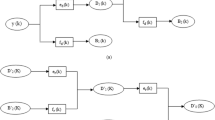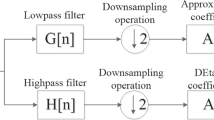Abstract
Constructing a set of watermarks of a specific structure may be one requirement for robust watermarking. This study aims to use the structure of Steiner triple systems to generate new watermarks. That is, the new watermark is a Steiner triple system built by using two smaller ones. The structure properties are examined to recognize watermarks at the receiver site. The main advantage is no information other than the mathematical structure has to be known for watermark recognition.Theoretical proof is given to verify the proposed watermark design method, and the experiment is conducted to confirm the theoretical behavior of the generated watermarks under random noise.









Similar content being viewed by others
References
Basu A, Cheng I, Wang T (2005) Balanced incomplete designs for 3d perceptual quality estimation. In: IEEE Int. Conf. Image Processing, 2005 (ICIP 2005). Genova, Italy, pp I–617–620
Bryant D, Horsley D (2009) A proof of lindner’s conjecture on embeddings of partial Steiner triple systems. J Comb Des 17:63–89
Bryant D, Martin G (2012) Small embeddings for partial triple systems of odd index. J Comb Theory A 119:283–309
Camtepe S, Yener B (2007) Combinatorial design of key distribution mechanisms for wireless sensor networks. IEEE ACM T Network 15:346–358
Colbourn CJ, Dinitz JH (1996) The CRC handbook of combinatorial designs. CRC, Boca Raton
Cox IJ, Miller ML, Bloom JA (2008) Digital watermarking, 2nd edn. Morgan Kaufmann, Boston
Dinitz J, Stinson D (1992) Contemporary design theory: a collection of surveys. A Brief Introduction to Design Theory. Wiley, New York, pp 1–12
Djordjevic I (2008) Quantum ldpc codes from balanced incomplete block designs. IEEE Commun Lett 12:389–391
Donovan DM, Grannell MJ, Griggs TS, Lefevre JG, McCourt T (2011) Self-embeddings of cyclic and projective steiner quasigroups. J Comb Des 19:16–27
Gersting JL (2006) Mathematical structures for computer science, 6th edn. W. H. Freeman, New York
Guerrini F, Okuda M, Adami N, Leonardi R (2011) High dynamic range image watermarking robust against tone-mapping operators. IEEE Trans Inf Forensics Secur 6:283–295
Hu HT, Chen WH (2012) A dual cepstrum-based watermarking scheme with self-synchronization. Signal Process 92:1109–1116
Kang IK, Lee CH, Lee HY, Kim JT, Lee HK (2005) Averaging attack resilient video fingerprinting. In: IEEE Int. Conf. Circuits and Systems, 2005 (ISCAS 2005). Kobe, Japan, pp 5529–5532
Kovalevskaya DI, Soloveva FI (2013) On the steiner quadruple systems of small rank which are embeddable into extended perfect binary codes. J Appl Ind Math 7:68–77
Lan L, Tai YY, Lin S, Memari B, Honary B (2008) New constructions of quasi-cyclic ldpc codes based on special classes of bibd’s for the awgn and binary erasure channels. IEEE T Commun 56:39–48
Liutkus A, Pinel J, Badeau R, Girin L, Richard G (2012) Informed source separation through spectrogram coding and data embedding. Signal Process 92:1937–1949
Patel A, Kosko B (2011) Noise benefits in quantizer-array correlation detection and watermark decoding. IEEE T Signal Proces 59:488–505
Petitcolas FAP, Anderson RJ, Kuhn MG (1998) Attacks on copyright marking systems. In: Aucsmith D (ed) Information hiding, second international workshop, IH98. Springer-Verlag, Portland, Oregon, U.S.A., pp 219–239
Ryser HJ (1963) Combinatorial mathematics. Math Assoc Amer. Buffalo, NY
Sadasivam S, Moulin P, Coleman T (2011) A message-passing approach to combating desynchronization attacks. IEEE Trans Inf Forensics Secur 6:894–905
Ostergard PRJ, Pottonen O, Phelps KT (2010) The perfect binary one-error-correcting codes of length 15: part iiXproperties. IEEE T Inform Theory 56:2571–2582
Trappe W, Wu M, Wang ZJ, Liu KJR (2003) Anti-collusion fingerprinting for multimedia. IEEE T Signal Proces 51:1069–1087
Tsai JS, Huang WB, Kuo YH, Horng MF (2012) Joint robustness and security enhancement for feature-based image watermarking using invariant feature regions. Signal Processing 92:1431–1445
Wang J, Lian S (2012) On the hybrid multi-watermarking. Signal Process 92:893–904
Wang K, Liu Q, Chen L (2012) Hierarchical reversible data hiding based on statistical information: Preventing embedding unbalance. Signal Process 92:2888–2900
Yang J, Liu P, Tan G (2004) The digital fingerprint coding based on ldpc. In: Int. Conf. Signal Processing, 2004 (ICSP ’04). Istanbul, Turkey, pp 2600–2603
Yang J, Xu X (2006) A robust anti-collusion coding in digital fingerprinting system. In: 8th International conference on signal processing. Guilin, China, pp 16–20
Yang ZF (2006a) Anti-collusion fingerprinting for digital rights protection. In: 9th International symposium on wireless personal multimedia communications. San Diego, U.S.A.
Yang ZF (2006b) Watermarking based on balanced incomplete block designs. In: 2006 International computer symposium. Tawan, R.O.C.
Yang ZF, Lee PC, Chen WH, Leu JG (2009) Enlargement of balanced-incomplete-block-designs-based watermarks. In: Fifth international conference on intelligent information hiding and multimedia signal processing. Kyoto, Japan, pp 332–335
Yang ZF, Wu MS (2008) Robustness of structure-based watermark by using balanced incomplete block designs. In: ISDA 2008. Kaohsiung City, Taiwan, pp 179–182
Yeh BC, Lin CH, Wu J (2010) Noncoherent spectral/spatial ocdma system using two-dimensional hybrid codes. IEEE/ISA J Opt Commun Networking 2:653–661
Zhang H, Shu H, Coatrieux G, Zhu J, Wu Q, Zhang Y, Zhu H, Luo L (2011a) Affine legendre moment invariants for image watermarking robust to geometric distortions. IEEE T Image Process 20:2189–2199
Zhang X, Qian Z, Ren Y, Feng G (2011b) Watermarking with flexible self-recovery quality based on compressive sensing and compositive reconstruction. IEEE Trans Inf Forensics Secur 6:1223–1232
Author information
Authors and Affiliations
Corresponding author
Rights and permissions
About this article
Cite this article
Yang, ZF., Chiou, SS. & Lee, JT. Watermark design based on Steiner triple systems. Multimed Tools Appl 72, 2177–2194 (2014). https://doi.org/10.1007/s11042-013-1513-x
Published:
Issue Date:
DOI: https://doi.org/10.1007/s11042-013-1513-x




